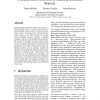Free Online Productivity Tools
i2Speak
i2Symbol
i2OCR
iTex2Img
iWeb2Print
iWeb2Shot
i2Type
iPdf2Split
iPdf2Merge
i2Bopomofo
i2Arabic
i2Style
i2Image
i2PDF
iLatex2Rtf
Sci2ools
81
Voted
IPM
2006
2006
A general matrix framework for modelling Information Retrieval
Content-oriented retrieval models are based on a document-term matrix, whereas link-oriented retrieval models are based on an adjacent (parentchild) matrix. Term frequency and inverse document frequency are key concepts in contentoriented retrieval, whereas pagerank, authorities and hubs are key concepts in link-oriented retrieval. We present in this paper a general matrix framework for modelling information retrieval (IR). The framework covers both content-oriented and linkoriented retrieval and, in addition, includes the structure of documents, the retrieval quality and the semantics of indexing terms. The benefit of this framework lies in its high level of reusability and ion. The framework improves information retrieval in the sense that system construction becomes significantly more efficient, and thus, better and more personalised systems can be build at lower costs.
Related Content
| Added | 13 Dec 2010 |
| Updated | 13 Dec 2010 |
| Type | Journal |
| Year | 2006 |
| Where | IPM |
| Authors | Thomas Rölleke, Theodora Tsikrika, Gabriella Kazai |
Comments (0)

